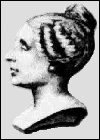












Thomas Fuller (1710-1790) |
Maria Agnesi (1718-1799) |
|
Carl Friedrich Gauss (1777-1855) |
Sophie Germain (1776-1831) |
|
Georg Cantor (1845-1918) |
Srinivasa Ramanujan
(1887-1920) 
| |
Paul Erdos
(1913-1996)  |
David Blackwell (1919-)  |
|
Evelyn Boyd Granville (1924-) 
|
Mary Ellen Rudin (1924-)  | |
Fern Hunt (194?-) |
Frank Morgan (195?-)  |
Ingrid Daubechies (1954-)  |